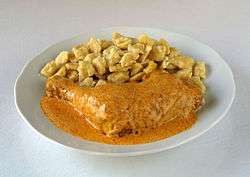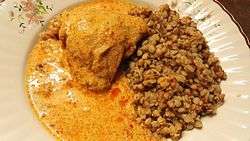Chicken paprikash
Chicken paprikash (Hungarian: paprikás csirke or csirkepaprikás) or paprika chicken is a popular dish of Hungarian origin and one of the most famous variations on the paprikas preparations common to Hungarian tables. The name is derived from the ample use of paprika, a spice commonly used in Hungarian cuisine.[1][2] The meat is typically simmered for an extended period in a sauce that begins with a paprika-infused roux.[3]

Preparation
The édes nemes (sweet paprika) is the preferred kind of paprika; it adds a rosy color as well as flavor.[1][4] Sometimes olive oil and sweet red or yellow peppers[4] and a small amount of tomato paste are used.[5] The dish bears a "family resemblance" to goulash, another paprika dish.[6]
The dish is traditionally served with "dumpling-like boiled egg noodles" (nokedli), a broad noodle similar to the German spätzle.[2][4] Other side dishes that it may be served with include tagliatelle (boiled ribbon noodles),[6] rice or millet.[7]
Variations
Food columnist Iles Brody's recipe called for chicken, onions, butter or lard, sweet paprika, green peppers, tomatoes, clove garlic, flour, and sour cream.[8][9] Other recipes are similar.[6] While quartered chicken parts are more traditional, modern interpretations of the recipe may call for boneless, skinless chicken thighs.[4][8]
A version of paprikash (паприкаш) exists in the Bulgarian cuisine, however it includes smaller amounts of paprika being added to the sautéed onion in the beginning of the cooking and then adding cubed, usually green, sweet peppers. The dish is centered on the latter.
Chicken paprikash is very popular among Ashkenazi Jews (especially those of Hungarian-Jewish descent); to conform to the laws of kashrut, sour cream or any dairy must be omitted, though vegan substitutes could be used. Tomatoes are usually included.[10]
In popular culture
In Bram Stoker's 1897 novel Dracula, Jonathan Harker dines on chicken paprikash during his journey through the Carpathian Mountains to Dracula's castle.
Chicken paprikash is mentioned twice in various Star Trek series. First in the 1995 episode, "Family Business", of Star Trek: Deep Space Nine, where Captain Sisko is cooking the dish after some successful negotiations. And a second time in the 1999 episode, "Course: Oblivion", of Star Trek: Voyager, in which instance Captain Janeway is preparing it for her weekly dinner with Commander Chakotay.
In the film Captain America: Civil War (2016), the superhero Vision attempts, unsuccessfully, to cook a paprikash for Scarlet Witch while they are sequestered in the Avengers compound in a bid to lift her spirits. His literal lack of taste and complete inexperience cooking stymies his effort.
In When Harry Met Sally, Harry tries to teach Sally to speak in a funny accent by repeating the phrase “Waiter, there is too much pepper in my paprikash.”
References
- Lukins, Sheila (1994), All Around the World Cookbook, Workman Publishing, p. 378
- Steves, Rick; Hewitt, Cameron (2011), Rick Steves' Budapest, Avalon Travel, p. 243
- O'Halloran, Jacinta (2007), Fodor's Budapest, Random House Digital, p. 81
- How to Cook, DK Publishing (Penguin), 2011, p. 52
- Amster, Linda; Sheraton, Mimi (2003), The New York Times Jewish Cookbook: More than 825 Traditional and Contemporary Recipes from Around the World, Macmillan, p. 156
- Grigson, Jane; Skargon, Yvonne (2006), Jane Grigson's Vegetable Book, University of Nebraska Press, pp. 390–91
- Kinderlehrer, Jane (2002), The Smart Chicken and Fish Cookbook: Over 200 Delicious and Nutritious Recipes for Main Courses, Soups, and Salads, Newmarket Press, p. 89
- Jones, Evan. Epicurean Delight: The Life and Times of James Beard (1992). Simon & Schuster: p. 111.
- Cohen, Jayne. Jewish Holiday Cooking: A Food Lover's Treasury of Classics and Improvisations (2008). Wiley and Sons: pp. 80–81.
- Marks, Gil (2010). The Encyclopedia of Jewish Food. Houghton Mifflen Harcourt. pp. 439–440. ISBN 978-0470391303.
